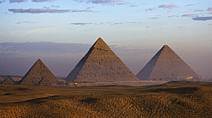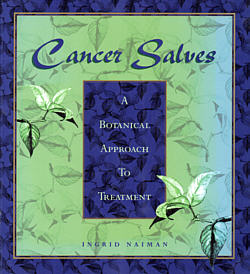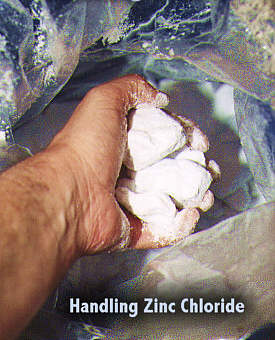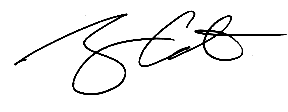

One of the primary compounds used in the
preparation of escharotics -- and this has been going on for centuries now -- is
zinc chloride.
There is nothing new about man's manufacture and use of this important zinc compound:
it's use goes far back into antiquity, and, in fact, it was even made and utilized
in the King's Chamber at the Great Pyramid at Giza.
1 Additionally, a careful
reading of the first two chapters of
Meditopia
shows that it is repeatedly shown as an important ingredient in the history of the art.
Zinc chloride is ever-present in the U.S. patent records of the past 150 years.
2


Sixteen years ago (around 2001), I had to address
the use of zinc chloride in escharotics in response to misleading information that
was provided by author, Ingrid Naiman.
3
I even
incorporated
my comments in the Cansema FAQ section. In addition to emphasizing how "caustic"
zinc chloride is,
4
Naiman goes so far as to say that zinc chloride is not
recommended for internal use.
5

I would not have strong opinions on this
subject were it not for the fact that I've been working with zinc chloride-based
escharotics since 1989, and have worked -- directly or indirectly -- with thousands
of users over that time. Certainly, there is room for abuse of zinc compounds,
if not used properly -- but so are most other things we normally regard as innocuous.
Taken in excess, salt is poisonous (hypernatremia)
6,
sugar is poisonous
7,
alcohol is poisonous
8,
and even water is poisonous (hyponatremia)
9.
Speaking more broadly, as Paracelsus noted 500 years ago, "Every medicine is a poison,
and every poison is a medicine. It all depends on the dosage." The current
scare tactics that are surfacing on social media and even in the
mainstream media -- (see
rebuttal to a recent
Dr. Oz hit piece) -- takes advantage of people who don't understand this.
It's always easy to demonize something when addressing people who don't have
the background to know any better.

At the risk of sounding annoyingly redundant --
because God only knows how many times I've addressed this issue in the past through
various media -- let's review the misinformation -- point by point -- that has
been circulated about zinc chloride:
-
 Zinc chloride is NOT horribly caustic. The word "caustic" has a specific meaning
in chemistry and
generally
refers to "strong bases, particularly alkalis", hence its use in common language to
describe high pH compounds: "caustic soda" (sodium hydroxide), "caustic potash" (potassium
hydroxide), "caustic lime" (calcium oxide), etc. This doesn't describe zinc chloride at
all, because
aqueous solutions of ZnCl2 have a pH of about 4 -- and there is no escharotic I've ever
made that isn't in the 4 to 6.5 pH range, which is
far less acidic that apple, orange, grape, or cranberry fruit juices. For all intents
and purposes, the action of zinc chloride when used escharotically has nothing to do with its pH --
but I see references to zinc chloride being "caustic" or "too acidic" on social media with some
regularity, and I grimace when confronted with such unmitigated ignorance on the subject.
Zinc chloride is NOT horribly caustic. The word "caustic" has a specific meaning
in chemistry and
generally
refers to "strong bases, particularly alkalis", hence its use in common language to
describe high pH compounds: "caustic soda" (sodium hydroxide), "caustic potash" (potassium
hydroxide), "caustic lime" (calcium oxide), etc. This doesn't describe zinc chloride at
all, because
aqueous solutions of ZnCl2 have a pH of about 4 -- and there is no escharotic I've ever
made that isn't in the 4 to 6.5 pH range, which is
far less acidic that apple, orange, grape, or cranberry fruit juices. For all intents
and purposes, the action of zinc chloride when used escharotically has nothing to do with its pH --
but I see references to zinc chloride being "caustic" or "too acidic" on social media with some
regularity, and I grimace when confronted with such unmitigated ignorance on the subject.
 What critics of zinc chloride-based escharotics "mean"
to say is that zinc chloride is corrosive to human (animal) tissue -- which, taken to an extreme, is another way of
saying that zinc chloride-based escharotics will indiscriminately eat away skin right on down
to the bone wherever you apply it. Experienced users of properly made escharotics know that this
laughably inaccurate.
What critics of zinc chloride-based escharotics "mean"
to say is that zinc chloride is corrosive to human (animal) tissue -- which, taken to an extreme, is another way of
saying that zinc chloride-based escharotics will indiscriminately eat away skin right on down
to the bone wherever you apply it. Experienced users of properly made escharotics know that this
laughably inaccurate.
 I've done a number of interviews -- (recent example:
my interview on my assessment
of Curaderm in comparison to true escharotics -- see also link above) -- where I've covered
sizeable areas of my skin with Cansema® to show that its "causticity" is exaggerated.
I've done a number of interviews -- (recent example:
my interview on my assessment
of Curaderm in comparison to true escharotics -- see also link above) -- where I've covered
sizeable areas of my skin with Cansema® to show that its "causticity" is exaggerated.
 As I pointed out in my Dr. Oz
rebuttal, properly made escharotics, used according to proven
instructions do NOT "attack" healthy tissue. In fact, consumers who incorrectly believe that
a given growth is cancerous, when it isn't, routinely complain that "black salve doesn't work."
The truth is that properly-made escharotics, when applied to healthy tissue, are not
SUPPOSED to work.
As I pointed out in my Dr. Oz
rebuttal, properly made escharotics, used according to proven
instructions do NOT "attack" healthy tissue. In fact, consumers who incorrectly believe that
a given growth is cancerous, when it isn't, routinely complain that "black salve doesn't work."
The truth is that properly-made escharotics, when applied to healthy tissue, are not
SUPPOSED to work.
- Zinc Chloride is NOT excessively painful when properly utilized. The argument that zinc chloride is inherently
painful runs parallel to the argument that
it's painful to use "Black Salve." I address this as
point 2 in my Dr. Oz. rebuttal.
- Zinc Chloride will NOT leave you disfigured. Again, this runs parallel to the argument
that "Black Salve" is disfiguring. I address this as
point 3 in my Dr. Oz rebuttal.
- Zinc Chloride will NOT leave 'gaping' holes in your body. This ALSO runs parallel to the
argument that this is one of Black Salve's properties. I address this as
point 4 in my Dr. Oz rebuttal.
- Zinc Chloride has been successfully used in internal formulas for many years.
Naiman has promoted this false principle, as well. 10
Damn it. Somebody should have told me
this 28 years ago, since I've been periodically taking internal versions of Cansema Tonic all
of this time, sometimes for months on end. (Nearly ever version, except for the first version
of Tonic III in 2003, has contained zinc chloride.) God only knows the horrible things that
will happen to me if I continue to take internal escharotics with zinc chloride
for yet ANOTHER 28 years! For all this talk about "intestinal damage" when taking
internal escharotics with zinc chloride, why is it that I've been working with
escharotics since 1989 and I have yet to hear of such a case? You want to know what
will happen if you take too much zinc chloride -- (which I do NOT recommend)?
You'll get nauseated and vomit.
 Again, in the small amounts of zinc chloride
that you'll find in properly-made internal
escharotics, this isn't an issue. If it were -- after 28 years -- I would know by now.
Again, in the small amounts of zinc chloride
that you'll find in properly-made internal
escharotics, this isn't an issue. If it were -- after 28 years -- I would know by now.

These are the main areas of misrepresentation as
it relates to most escharotics, in general, and zinc chloride, in particular. Nonetheless,
if any reader has a question that they don't feel we cover comprehensively, they can always
write to us at
support@herbhealers.com.
 Greg Caton
Greg Caton
Medical Researcher
Alpha Omega Labs --- Guayaquil, Ecuador
May 30, 2017